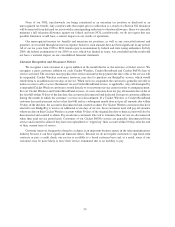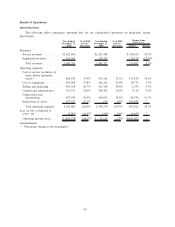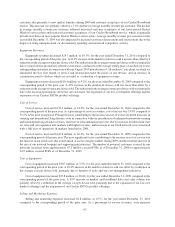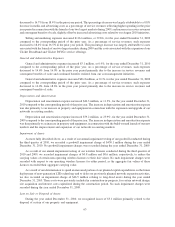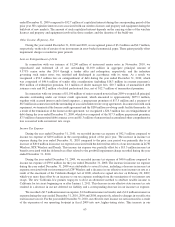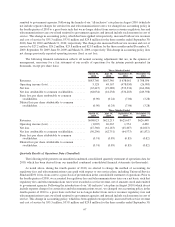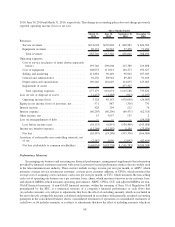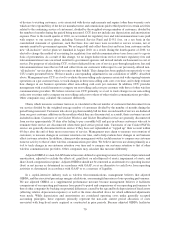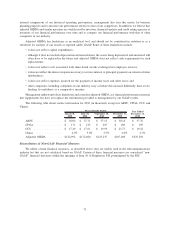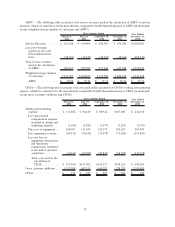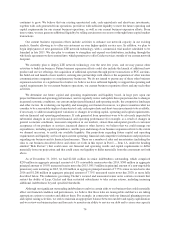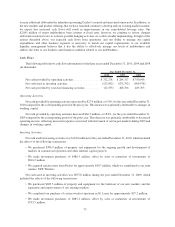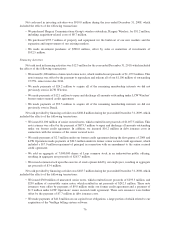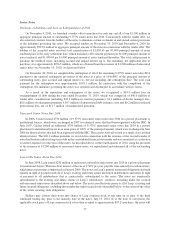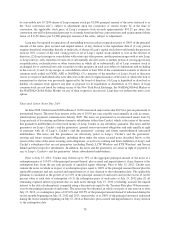Cricket Wireless 2010 Annual Report Download - page 75
Download and view the complete annual report
Please find page 75 of the 2010 Cricket Wireless annual report below. You can navigate through the pages in the report by either clicking on the pages listed below, or by using the keyword search tool below to find specific information within the annual report.excluded from the most directly comparable measure so calculated and presented. See “Reconciliation of Non-
GAAP Financial Measures” below for a reconciliation of ARPU, CPGA, CCU and adjusted OIBDA to the most
directly comparable GAAP financial measures.
ARPU is service revenue divided by the weighted-average number of customers, divided by the number of
months during the period being measured. Management uses ARPU to identify average revenue per customer, to
track changes in average customer revenues over time, to help evaluate how changes in our business, including
changes in our service offerings, affect average revenue per customer, and to forecast future service revenue. In
addition, ARPU provides management with a useful measure to compare our subscriber revenue to that of other
wireless communications providers. Prior to the fourth quarter of 2010, we accounted for regulatory fees and
telecommunications taxes paid with respect to our service plans, including Universal Service Fund and E-911 fees,
on a net basis in the consolidated statement of operations, such that these fees and taxes were recorded as service
revenue, net of amounts owed and remitted to government agencies. We no longer bill and collect these fees and
taxes from customers on the new “all-inclusive” service plans we launched in August 2010. As a result, during the
fourth quarter of 2010, we elected to change the method of accounting for regulatory fees and telecommunications
taxes from a net to a gross basis of presentation. As a result of this change, we no longer deduct from service
revenues regulatory fees and telecommunications taxes owed and remitted to government agencies and instead
include such amounts in cost of service. For purposes of calculating ARPU, we have deducted from service
revenues pass-through regulatory fees and telecommunications taxes that we bill and collect from our customers
with respect to our previously-offered non-“all-inclusive” service plans, which we remit on their behalf. This
change has been applied retrospectively to our ARPU results presented below. We have made a corresponding
adjustment in our calculation of CCU, as described below.
Customers of our Cricket Wireless and Cricket Broadband service are generally disconnected from service
approximately 30 days after failing to pay a monthly bill. Customers of our Cricket PAYGo service are generally
disconnected from service if they have not replenished or “topped up” their account within 60 days after the end of
their current term of service. Therefore, because our calculation of weighted-average number of customers includes
customers who have yet to disconnect service because they have either not paid their last bill or have not replenished
or “topped up” their account, ARPU may appear lower during periods in which we have significant disconnect
activity. We believe investors use ARPU primarily as a tool to track changes in our average revenue per customer
and to compare our per customer service revenues to those of other wireless communications providers. Other
companies may calculate this measure differently.
CPGA is selling and marketing costs (excluding applicable share-based compensation expense included in
selling and marketing expense), and equipment subsidy (generally defined as cost of equipment less equipment
revenue), less the net loss on equipment transactions and third-party commissions unrelated to the initial customer
acquisition, divided by the total number of gross new customer additions during the period being measured. The net
loss on equipment transactions unrelated to the initial customer acquisition includes the revenues and costs
associated with the sale of wireless devices to existing customers as well as costs associated with device
replacements and repairs (other than warranty costs which are the responsibility of the device manufacturers).
Commissions unrelated to the initial customer acquisition are commissions paid to third parties for certain activities
related to the continuing service of customers. We deduct customers who do not pay their monthly bill for their
second month of service from our gross customer additions, which tends to increase CPGA because we incur the
costs associated with this customer without receiving the benefit of a gross customer addition. Management uses
CPGA to measure the efficiency of our customer acquisition efforts, to track changes in our average cost of
acquiring new subscribers over time, and to help evaluate how changes in our sales and distribution strategies affect
the cost-efficiency of our customer acquisition efforts. In addition, CPGA provides management with a useful
measure to compare our per customer acquisition costs with those of other wireless communications providers. We
believe investors use CPGA primarily as a tool to track changes in our average cost of acquiring new customers and
to compare our per customer acquisition costs to those of other wireless communications providers. Other
companies may calculate this measure differently.
CCU is cost of service and general and administrative costs (excluding applicable share-based compensation
expense included in cost of service and general and administrative expense) plus net loss on equipment transactions
and third-party commissions unrelated to the initial customer acquisition (which includes the gain or loss on the sale
69


